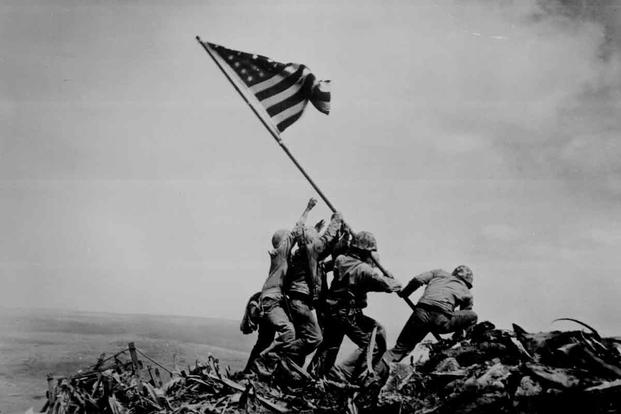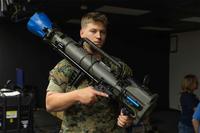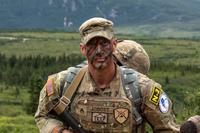Pvt. George Coe Browning is finally coming home.
Nearly 80 years after the Marine went missing in action during the bloody invasion of Iwo Jima, the former Bergen County resident will be laid to rest Monday in Englewood's Brookside Cemetery alongside his mother. A Marine Honor Guard and his lone surviving relatives will honor his memory at the grave.
"He's finally going to go back to where his mother is," said Peter Clay, Browning's 81-year-old nephew, who is flying in from Virginia with his wife and daughter for the funeral.
Clay grew up in Englewood, but was just a baby when his uncle died on the battlefield. Clay says his mother, who was Browning's older sister, didn't talk much about the tragedy -- mainly because the family didn't know much.
"All these years, we really didn't know what happened," Clay said.
But thanks largely to the work of WFI Research Group, a Florida-based nonprofit that works with the military to identify missing soldiers, Browning's remains were positively identified in April and he'll be given a military funeral on Monday.
"The Marine Corps is going to do the ceremony, and they have provided the transportation for me, my wife, and my daughter," said Clay.
Browning was born in Minneapolis, but appears to have grown up in and around Englewood in Bergen County, according to military records obtained by NJ Advance Local. His mother, Carol Coe Browning, lived on East Clinton Avenue in Tenafly until her death in 1986, records show.
Trained as a radio field operator, Browning was reported missing in action on Feb. 20, 1945, the second day of the invasion of Iwo Jima. Dispatched from his unit to pick up radio gear on an adjoining beach, Browning never made it back and was presumed dead.
Browning's body was never recovered, so he became one of the 50 "unknown soldiers" killed in the battle and initially buried on Iwo Jima. There were 6,821 service members killed during the five-week assault. When the battle was over, Browning's remains and the remains of other unknown soldiers were shipped to a laboratory in Saipan.
In Saipan, the military created a file with Browning's dental records and a sketch of the remains depicting the wounds. Clay said his uncle was then interred in the Manilla Cemetery in the Philippines, his file marked X12. Until April, he was one of one of roughly 72,000 service members from World War II still listed as Missing in Action.
The break in the case came in January 2019, when Clay received a letter from Ted Darcy, a retired Marine gunnery sergeant who runs the WFI Research Group with his wife in Pensacola, Florida.
"Are you the kin of Pvt. George Coe Browning?" Darcy wanted to know. Clay was taken aback.
"After all these years," Clay said.
Since 1991, Darcy has made it his mission to help the military identify missing service members. He's compiled a database with the files of 33,000 MIA service members and works with the Defense POW/MIA Accounting Agency to identify missing Marines.
Darcy, 73, said it's painstaking work getting military agencies to then convince them to exhume remains, but it's worth it when the Defense POW/MIA Accounting Agency makes a positive identification and notifies the family. To date, WFI Research Group takes credit for identifying 196 missing Marines, according to its website.
"I do it for free," Darcy said. "The families have already paid enough." Darcy encourages families of missing service members to reach out to him at wreck2@comcast.net.
In 2019, Darcy turned over 50 sets of records of unknown Iwo Jima service members to the Defense POW/MIA Accounting Agency to be identified.
"Then the pandemic hit and everything slowed down," Darcy said. It took five years, but in April 2023, the Defense POW/MIA Accounting Agency issued a disinterment order to examine the remains of X12.
Clay said he and Browning's younger sister, Patricia, gave DNA samples to the military. But Clay said Patricia didn't live to see the day her missing brother was found.
On April 15, the Defense POW/MIA Accounting Agency posted that Pvt. George Coe Browning was missing no more.
"DPAA historians conducting on-going [sic] research into the Unknowns associated with the Battle of Iwo Jima found that one set of Unknown remains could be associated with Pvt. Browning," the post said. "This set of remains was disinterred....and transferred to a DPAA laboratory for further study. The laboratory analysis and the totality of the circumstantial evidence available established the remains as those of Pvt. Browning."
Clay said he's seen the sketch of the remains and it's clear to him that his uncle was killed by mortar fire. Browning's mother and two sisters died without ever knowing what happened.
Although he never met his uncle, Clay said Browning had a huge impact on his life. In 1961, Clay was 18 years old and had been accepted to CW Post College on Long Island. But he didn't have money for tuition.
Clay said his mother went to the bank, opened a safe deposit box, and gave him the money for tuition. The money, she told him, had come from savings bonds Browning had bought while he was in the service.
"My mother said to me, 'Peter, my brother George left these for you,'" Clay recalled. "He paid my way through college right then and there."
He graduated four years later with a degree in psychology, then joined the Marine Corps and went to Vietnam. On Monday, he will lay his uncle to rest in graveside service that begins at 1:30 p.m.
"It's been an interesting voyage," he said.
© 2024 Advance Local Media LLC.
Visit nj.com.
Distributed by Tribune Content Agency, LLC.











